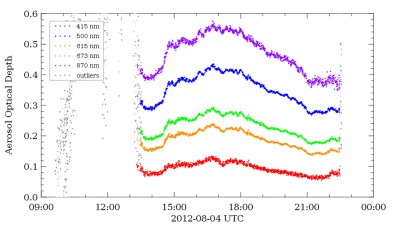
The Shortwave Array Spectroradiometer-Hemispheric (SASHE) is a ground-based instrument that measures both direct and diffuse shortwave irradiance. SASHE provides hyperspectral measurements from about 350 nm to 1700 nm at a wavelength resolution from 1 to several nanometers.
The SASHE Aerosol Optical Depth (SASHE AOD) VAP processes the files created by the SASHE Langley VAP to yield a robust calibration time series. This calibration time series is used to yield measurements of spectral direct-normal transmittance, spectral diffuse transmittance, and spectral total optical depth. Subtracting Rayleigh optical depth (scaled to locally measured pressure) and ozone optical depth results in the aerosol optical depth (AOD).
To date, the AODs derived from the SASHE have been compared with measurements from other instruments, including the multifilter rotating shadowband radiometer (MFRSR), normal incidence multifilter radiometer, and the CIMEL sunphotometer at the ARM Southern Great Plains site, and the MFRSR at the ARM Mobile Facility (AMF) Cape Cod deployment site. The comparison has been favorable, with AODs agreeing to within ± 0.02; usually the agreement is better than this. However, below about 400 nm, the agreement between the AOD measured by the SASHE and the CIMEL sunphotometer is far less robust—an issue that is now being vigorously investigated.
Some of the AODs derived from low-light-level signals exhibit noise. This noise can be significantly reduced by applying a so-called PCA noise filter, and there are plans to implement this in the future. However, the data are now being exhibited without the filter so the user can evaluate data that have received the minimum processing necessary to produce reliable AODs.
To access these data, log in to the Data Archive. (Go here to request an account.)

